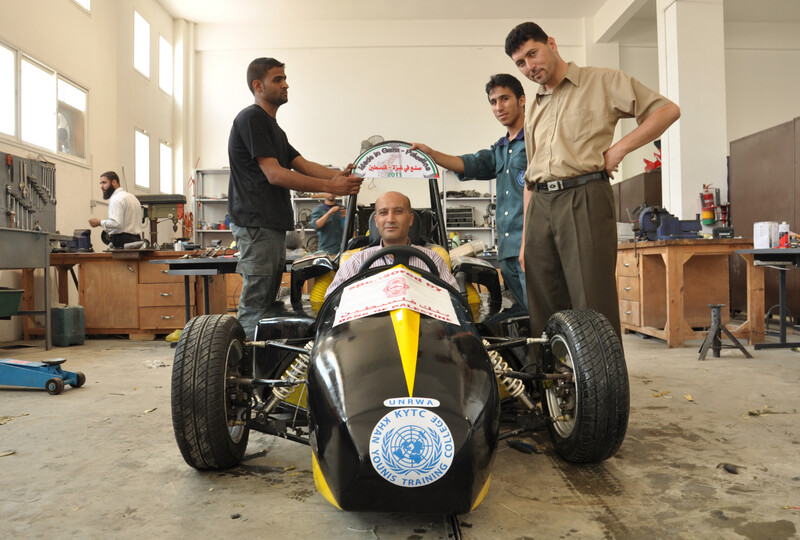The Electronic Intifada Khan Younis 29 June 2011

The author sits in the Formula Student race car developed by technical college students in the Gaza Strip.
The Electronic Intifada“Please make sure the oil is being pumped into the pipe,” Muhammad al-Najjar told his colleague Nidal al-Badrasawi. Al-Najjar, an auto-electronics student at the vocational training college run by the UN agency for Palestine refugees (UNRWA) in the southern Gaza Strip city of Khan Younis, was busy on Thursday. Along with his eight other colleagues, he was trying to make sure that their Formula Student racing car’s design was perfect, following four months of relentless work.
Formula Student is an annual engineering competition based in the UK in which teams of students in different countries design, build and test a single seat racing car to specific, high standards and rules. Some of the cars are then tested and raced on the famous Silverstone track in the UK (see formulastudent.com).
Yet the Gaza car will not race in the UK as the team who built it were denied visas by the British embassy in Amman as they lack a financial sponsor.
The college’s automobile electronics department is located in the middle of rolling sand dunes to the west of Khan Younis. There, al-Najjar and his colleagues, with the help of two mechanical engineers, built a racing car — the first of its kind in the besieged coastal territory.
Engineered in Gaza
Cleaning the oil off his hands, Nidal al-Badrasawi described the car’s manufacturing process to The Electronic Intifada.
“The dean of our college, Dr. Ghassan Abu Orf, brought to us the idea of manufacturing such a car. We were excited about this new experiment in Gaza, and actually we found it difficult in the beginning, but with the help of our supervisors, things went smoother,” he said.
“All the parts of this car have been reformulated here in the Gaza Strip,” al-Badrasawi added, “because we faced difficulties bringing parts from abroad. The car is 2.7 meters long, and 1.7 meters wide.”
Usama al-Othmani, another student who participated in the project, was checking the rear of the car. He was excited about the college’s achievement.
“Over the past four months, we were divided into two teams; administrative and technical,” he said, adding that one woman was part of the group, though she was not present for the interview.
“Each team played its role very well. The manufacture was not that easy, beginning with fabricating the car’s external body, then the engine installation and fixing the brakes, wheels and steering,” al-Othmani explained. “We looked for similar cars like the Italian-made Fiat Punto, so we installed parts of that type of car, after reformulating them using special metal machines.”
Al-Othmani said that the shock absorber, the steering accessories and the suspension were all locally-sourced.
The three students hope that they will be able to manufacture additional cars of the same type. They also hope that the Formula Student car can compete in competitions across the region and, eventually, worldwide.
Israel refuses to allow parts into Gaza
Engineer Ziyad al-Namla of the vocational training college in Khan Younis supervised the team throughout the four-month project, up to the final stages.
“After we were instructed to start manufacturing this car by Dean Abu Orf, we first created the design for the car using computer-aided design software such as AutoCAD,” al-Namla told The Electronic Intifada.
“Afterwards, we ordered parts we needed from Italy, and we managed to have them shipped to the Ashdod sea port in Israel just north of Gaza. Unfortunately, we were not able to bring them into Gaza due to Israel’s restrictions under the blockade,” he said.
Since June 2007, Israel has enforced a blockade on Gaza that prevents the import of a long list of materials including steel and electronics. The siege has badly impacted Gaza industries.
Without the ordered parts, al-Namla explained, the team decided to rely on whatever material was readily-available inside Gaza.
“The external shape of the car, which the students made themselves, is made of fiberglass and steel bars, and then they painted it black,” he said.
The engine and the transmission of the car were taken from a Honda motorcycle.
“In fact, the car’s torque comes from the back, not the front, because we used a motorcycle engine with a 600-cubic centimeter capacity and a speed limit of 220 kilometers per hour,” al-Namla said.
Al-Namla estimated the manufacturing costs at about $30,000.
Creativity in construction
Ali Abu Sharekh, an electrical engineer with the college and a supervisor for the project, said that this endeavor enabled students’ creativity.
“We were determined to make something that many others around the world can do, so we began designing this car — especially after we heard there will be a UK-based competition of such cars this summer,” he said, referring to the annual Formula Student race which will be held in mid July.
However, according to a report from the Bethlehem-based Ma’an News Agency, the British embassy in Amman dashed the team’s hopes of traveling to the UK by refusing them visas. The report said, based on an unnamed sources, that the denial was due to a lack of financial sponsorship (“Gazan Formula student team denied UK visas,” 22 June 2011).
Despite the disappointment, al-Najjar hoped that the project will show that Palestinians in the Gaza Strip can help advance technological and engineering innovations.
“Let me proudly say that Palestinian youth, especially in the besieged Gaza Strip, and despite the many hardships here, are able to create something,” al-Najjar said.
“We hope all such difficulties [are removed] from our way, and that those in support of Palestinians worldwide can make a difference by lifting Israel’s blockade on Gaza, so that we can accomplish more and more.”
Rami Almeghari is a journalist and university lecturer based in the Gaza Strip.




